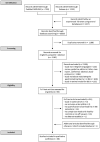Intestinal barrier dysfunction in irritable bowel syndrome: a systematic review
- PMID: 33717210
- PMCID: PMC7925957
- DOI: 10.1177/1756284821993586
Intestinal barrier dysfunction in irritable bowel syndrome: a systematic review
Abstract
Background and aim: Irritable bowel syndrome (IBS) is a complex and heterogeneous disorder. Sensory, motor and barrier dysfunctions are the key physiological endophenotypes of IBS. Our aim is to review studies evaluating barrier dysfunction in adults and children with IBS, as well as to link those changes with IBS symptomatology and quality of life.
Methods: A comprehensive and systematic review of multiple databases was performed up to March 2020 to identify studies comparing intestinal permeability in IBS patients with healthy controls. Both in vivo and in vitro studies were considered.
Results: We identified 66 studies, of which 27 used intestinal probes to quantify barrier function. The prevalence of barrier dysfunction differed between PI-IBS (17-50%), IBS-D (37-62%) and IBS-C (4-25%). At a group level, permeability was increased compared with healthy controls in IBS-D (9/13 studies) and PI-IBS (4/4 studies), but only a minority of IBS-C (2/7 studies) and not in the only IBS-M study. All four studies in children with IBS demonstrated loss of barrier function. A heterogeneous set of tight junction genes were found to be altered in small and large intestines of adults with IBS, but these have not been evaluated in children. Positive associations were identified between barrier dysfunction and bowel disturbances (6/9 studies), abdominal pain (9/13 studies), overall symptom severity (1/6 studies), depression and anxiety (1/1 study) and quality of life (1/4 studies). Fecal slurry or supernatants of IBS patients were found to induce barrier disruption in animal models (5/6 studies).
Conclusions: Barrier dysfunction is present in a significant proportion of adult and all pediatric IBS studies, especially in the IBS-D and PI-IBS subtype. The majority of studies indicated a positive association between loss of barrier function and symptoms such as abdominal pain and changes in the bowel function.
Keywords: functional gastrointestinal disorders; immune cells; microbiome; occludin; zonula occludens.
© The Author(s), 2021.
Conflict of interest statement
Conflict of interest statement: The authors declare that there is no conflict of interest.
Figures




References
-
- Ford AC, Lacy BE, Talley NJ. Irritable bowel syndrome. N Engl J Med 2017; 376: 2566–2578. - PubMed
-
- Holtmann GJ, Ford AC, Talley NJ. Pathophysiology of irritable bowel syndrome. Lancet Gastroenterol Hepatol 2016; 1: 133–146. - PubMed
-
- Simrén M, Tack J. New treatments and therapeutic targets for IBS and other functional bowel disorders. Nat Rev Gastroenterol Hepatol 2018; 15: 589–605. - PubMed
-
- Sibelli A, Chalder T, Everitt H, et al.. A systematic review with meta-analysis of the role of anxiety and depression in irritable bowel syndrome onset. Psychol Med 2016; 46: 3065–3080. - PubMed
Publication types
LinkOut - more resources
Full Text Sources
Other Literature Sources
Medical
Research Materials
Miscellaneous

